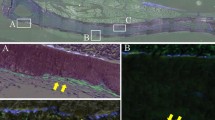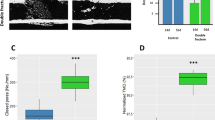Abstract
Introduction
Formation of new blood vessels is essential for the process of fracture healing.
Materials and methods
We investigated the expression of the angiogenic factor pleiotrophin/HB-GAM in a closed fracture model in rats by immunohistochemical methods.
Results
Histologically, 5 days after fracture the callus was predominantly composed of fibrous tissue. On day 10 a prominent chondral callus connected both ends of the fractured tibia. There was a continuous transition from the chondral callus to the newly formed bone adjacent to the corticalis of the tibia. On day 15 the amount of woven bone had increased, and in 3 of 5 animals the proximal and distal tibiae were connected by a bridge of woven bone. Pleiotrophin could be immunostained in fibroblasts and endothelial cells of the fibrous tissue between the fractured tibia ends. The chondral callus remained largely pleiotrophin-negative. Only single chondrocytes adjacent to the newly formed bone were pleiotrophin-positive. On days 10 and 15 strong immunoreactivity for pleiotrophin in the well vascularized, newly formed, woven bone was detectable. Osteoblasts, endothelial cells and fibroblasts were strongly pleiotrophin-positive.
Conclusions
These results show the presence of the angiogenic peptide pleiotrophin during fracture healing.




Similar content being viewed by others
References
Bonnarens F, Einhorn TA (1984) Production of a standard closed fracture in laboratory animal bone. J Orthop Res 2:97–101
Brookes M, Revell WJ (1998) Blood supply of bone. Springer, Berlin Heidelberg New York
Callard R, Gearing A (1994) The cytokine facts book. Academic Press, London
Dreyfuß J, Brunet-de Carvalho N, Duprez D, Vigny M (1998) HB-GAM/pleiotrophin: localization of mRNA and protein in the chicken developing leg. Int J Dev Biol 42: 189–198
Einhorn TA (1998) The cell and molecular biology of fracture healing. Clin Orthop 355: 7–21
Fang W, Hartmann N, Chow DT, Riegel AT, Wellstein A (1992) Pleiotrophin stimulates fibroblasts and endothelial and epithelial cells and is expressed in human cancer. J Biol Chem 267: 25889–25897
Ferrara N (1999) Molecular and biological properties of vascular endothelial growth factor. J Mol Med 77:527–543
Frost HM (1989) The biology of fracture healing. An overview for clinicians. Part I. Clin Orthop 248:283–293
Gerber HP, Vu TH, Ryan AM, Kolwalski J, Werb Z, Ferrara N (1999) VEGF couples hypertrophic cartilage remodeling, ossification and angiogenesis during endochondral bone formation. Nat Med 5:623–628
Hsiu-Jeng Y, Yong YH, Jan X, Chung Y, Deul TF (1998) Upregulation of pleiotrophin gene expression in developing microvasculature, macrophages, and astrocytes after acute ischemic brain injury. J Neurosci 18:3699–3707
Kurtz A, Schulte AM, Wellstein A (1995) Pleiotrophin and midkine in normal development and tumor biology.Crit Rev Oncog 6:151–177
Li YS, Gurrieri M, Deul TF (1990) Pleiotrophin gene expression is highly restricted and is regulated by plateled-derived growth factor. Biochem Biophys Res Comm 184:427–432
Misiadis TA, Salmivirta M, Muramatsu T, Muramatsu H, Rauvala H, Lehtonen E, Jalkanen M, Thesleff I (1992) Expression of the heparin binding cytokines, midkine (MK) and HB-GAM (pleitrophin), is associated with epithelial-mesenchymal interactions during fetal development and organogenesis: Development 121:37–51
Neame PJ, Young CN, Brock CW, Treep JT, Ganey TM, Sasse J, Rosenberg LC (1993) Pleiotrophin is an abundant protein in dissociative extracts of bovine fetal epiphyseal cartilage and nasal cartilage from newborns. J Orthop Res 11:479–491
Petersen W, Rafii M (2001) Immunolocalisation of pleiotrophin on the growth plate of mice. Arch Orthop Trauma Surg 121:354
Relf M, LeJeune S, Scott PA, Fox S, Smith K, Leek R, Moghaddam A, Withehouse R, Bicknell R, Harris AL (1997) Expression of the angiogenic factors vascular endothelial growth factor, acidic and basic fibroblast growth factor, tumor growth factor beta-1, platelet derived endothelial growth factor, placenta growth factor, and pleiotrophin in human primary breast cancer and its relation to angiogenesis. Cancer Res 57:963–969
Schmidmaier G, Wildemann B, Cromme F, Kandziora F, Haas NP, Raschke M (2002) Bone morphogenetic protein-2 coating of titanium implants increases biomechanical strength and accelerates bone remodeling in fracture treatment: a biomechanical and histological study in rats. Bone 30:816–822
Shinji I, Kaksonen M, Raulo E, Kinnunen T, Fages C, Meng X, Lasko M, Rauvala H (1998) Osteoblast recruitment and bone formation enhanced by cell matrix-associated heparin-binding growth associated molecule (HB-GAM). J Cell Biol 143:1113–1128
Tezuka KS, Takeshita Y, Hakeda M, Kumagawa R, Kikuno R, Hashimoto-Gotoh (1990) Isolation of mouse and human cDNA clones encoding a protein expressed specifically in osteoblasts and brain tissue. Biochem Biophys Res Comm 173:246–251
Vanderwinden JM, Mailleux P, Schiffmann SN, Vanderhaeghen JJ (1992) Cellular distribution of the new growth factor pleiotrophin (HB-GAM) mRNA in developing and adult rat tissues. Anat Embryol 186:387–406
Zhang N, Deul TF (1999) Pleiotrophin and midkine, a family of mitogenic and angiogenic heparin-binding growth and differentiation factors. Curr Opin Hematol 6:223–234
Acknowledgements
We wish to thank Frank Lichte, Karin Stengel and Regine Worm for their expert technical assistance. This work was supported by a grant from the ‘Forschungsschwerpunkt Muskel- und Skelettsystem’ of the Medical Faculty of the University of Kiel and by a grant from the Deutsche Forschungsgemeinschaft (DFG, Schm 1436/1–1).
Author information
Authors and Affiliations
Corresponding author
Rights and permissions
About this article
Cite this article
Petersen, W., Wildemann, B., Pufe, T. et al. The angiogenic peptide pleiotrophin (PTN/HB-GAM) is expressed in fracture healing: an immunohistochemical study in rats. Arch Orthop Trauma Surg 124, 603–607 (2004). https://doi.org/10.1007/s00402-003-0582-0
Received:
Published:
Issue Date:
DOI: https://doi.org/10.1007/s00402-003-0582-0




